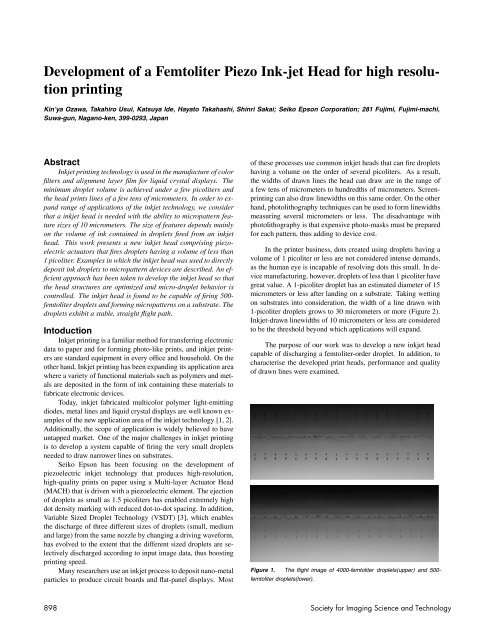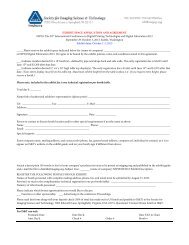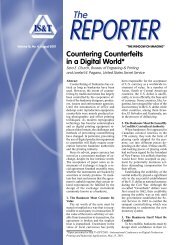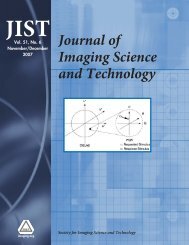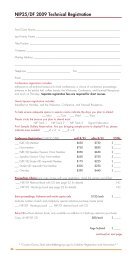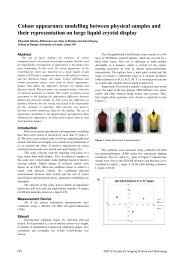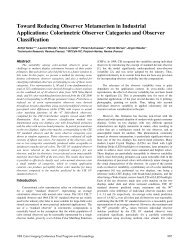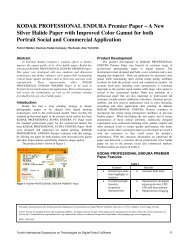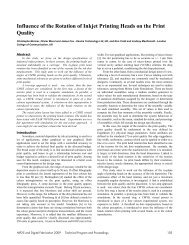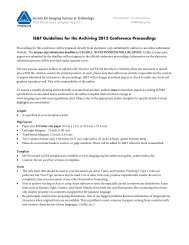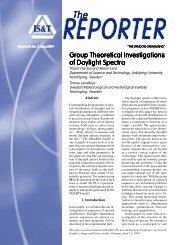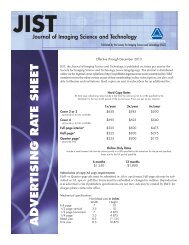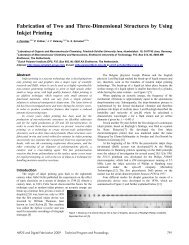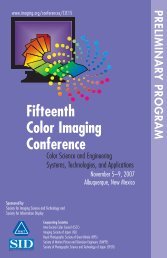Development of a Femto Liter Piezo Ink-jet Head for High Resolution ...
Development of a Femto Liter Piezo Ink-jet Head for High Resolution ...
Development of a Femto Liter Piezo Ink-jet Head for High Resolution ...
Create successful ePaper yourself
Turn your PDF publications into a flip-book with our unique Google optimized e-Paper software.
<strong>Development</strong> <strong>of</strong> a <strong>Femto</strong>liter <strong>Piezo</strong> <strong>Ink</strong>-<strong>jet</strong> <strong>Head</strong> <strong>for</strong> high resolution<br />
printing<br />
Kin’ya Ozawa, Takahiro Usui, Katsuya Ide, Hayato Takahashi, Shinri Sakai; Seiko Epson Corporation; 281 Fujimi, Fujimi-machi,<br />
Suwa-gun, Nagano-ken, 399-0293, Japan<br />
Abstract<br />
<strong>Ink</strong><strong>jet</strong> printing technology is used in the manufacture <strong>of</strong> color<br />
Þlters and alignment layer Þlm <strong>for</strong> liquid crystal displays. The<br />
minimum droplet volume is achieved under a few picoliters and<br />
the head prints lines <strong>of</strong> a few tens <strong>of</strong> micrometers. In order to expand<br />
range <strong>of</strong> applications <strong>of</strong> the ink<strong>jet</strong> technology, we consider<br />
that a ink<strong>jet</strong> head is needed with the ability to micropattern feature<br />
sizes <strong>of</strong> 10 micrometers. The size <strong>of</strong> features depends mainly<br />
on the volume <strong>of</strong> ink contained in droplets Þred from an ink<strong>jet</strong><br />
head. This work presents a new ink<strong>jet</strong> head comprising piezoelectric<br />
actuators that Þres droplets having a volume <strong>of</strong> less than<br />
1 picoliter. Examples in which the ink<strong>jet</strong> head was used to directly<br />
deposit ink droplets to micropattern devices are described. An ef-<br />
Þcient approach has been taken to develop the ink<strong>jet</strong> head so that<br />
the head structures are optimized and micro-droplet behavior is<br />
controlled. The ink<strong>jet</strong> head is found to be capable <strong>of</strong> Þring 500-<br />
femtoliter droplets and <strong>for</strong>ming micropatterns on a substrate. The<br />
droplets exhibit a stable, straight ßight path.<br />
Intoduction<br />
<strong>Ink</strong><strong>jet</strong> printing is a familiar method <strong>for</strong> transferring electronic<br />
data to paper and <strong>for</strong> <strong>for</strong>ming photo-like prints, and ink<strong>jet</strong> printers<br />
are standard equipment in every <strong>of</strong>Þce and household. On the<br />
other hand, <strong>Ink</strong><strong>jet</strong> printing has been expanding its application area<br />
where a variety <strong>of</strong> functional materials such as polymers and metals<br />
are deposited in the <strong>for</strong>m <strong>of</strong> ink containing these materials to<br />
fabricate electronic devices.<br />
Today, ink<strong>jet</strong> fabricated multicolor polymer light-emitting<br />
diodes, metal lines and liquid crystal displays are well known examples<br />
<strong>of</strong> the new application area <strong>of</strong> the ink<strong>jet</strong> technology [1, 2].<br />
Additionally, the scope <strong>of</strong> application is widely believed to have<br />
untapped market. One <strong>of</strong> the major challenges in ink<strong>jet</strong> printing<br />
is to develop a system capable <strong>of</strong> Þring the very small droplets<br />
needed to draw narrower lines on substrates.<br />
Seiko Epson has been focusing on the development <strong>of</strong><br />
piezoelectric ink<strong>jet</strong> technology that produces high-resolution,<br />
high-quality prints on paper using a Multi-layer Actuator <strong>Head</strong><br />
(MACH) that is driven with a piezoelectric element. The ejection<br />
<strong>of</strong> droplets as small as 1.5 picoliters has enabled extremely high<br />
dot density marking with reduced dot-to-dot spacing. In addition,<br />
Variable Sized Droplet Technology (VSDT) [3], which enables<br />
the discharge <strong>of</strong> three different sizes <strong>of</strong> droplets (small, medium<br />
and large) from the same nozzle by changing a driving wave<strong>for</strong>m,<br />
has evolved to the extent that the different sized droplets are selectively<br />
discharged according to input image data, thus boosting<br />
printing speed.<br />
Many researchers use an ink<strong>jet</strong> process to deposit nano-metal<br />
particles to produce circuit boards and ßat-panel displays. Most<br />
<strong>of</strong> these processes use common ink<strong>jet</strong> heads that can Þre droplets<br />
having a volume on the order <strong>of</strong> several picoliters. As a result,<br />
the widths <strong>of</strong> drawn lines the head can draw are in the range <strong>of</strong><br />
a few tens <strong>of</strong> micrometers to hundredths <strong>of</strong> micrometers. Screenprinting<br />
can also draw linewidths on this same order. On the other<br />
hand, photolithography techniques can be used to <strong>for</strong>m linewidths<br />
measuring several micrometers or less. The disadvantage with<br />
photolithography is that expensive photo-masks must be prepared<br />
<strong>for</strong> each pattern, thus adding to device cost.<br />
In the printer business, dots created using droplets having a<br />
volume <strong>of</strong> 1 picoliter or less are not considered intense demands,<br />
as the human eye is incapable <strong>of</strong> resolving dots this small. In device<br />
manufacturing, however, droplets <strong>of</strong> less than 1 picoliter have<br />
great value. A 1-picoliter droplet has an estimated diameter <strong>of</strong> 15<br />
micrometers or less after landing on a substrate. Taking wetting<br />
on substrates into consideration, the width <strong>of</strong> a line drawn with<br />
1-picoliter droplets grows to 30 micrometers or more (Figure 2).<br />
<strong>Ink</strong><strong>jet</strong>-drawn linewidths <strong>of</strong> 10 micrometers or less are considered<br />
to be the threshold beyond which applications will expand.<br />
The purpose <strong>of</strong> our work was to develop a new ink<strong>jet</strong> head<br />
capable <strong>of</strong> discharging a femtoliter-order droplet. In addition, to<br />
characterise the developed print heads, per<strong>for</strong>mance and quality<br />
<strong>of</strong> drawn lines were examined.<br />
Figure 1. The ßight image <strong>of</strong> 4000-femtoliter droplets(upper) and 500-<br />
femtoliter droplets(lower).<br />
898 Society <strong>for</strong> Imaging Science and Technology
<strong>Head</strong> design<br />
Drop size modulation demands consideration <strong>of</strong> many parameters,<br />
such as hydrodynamics, head structure and driving<br />
wave<strong>for</strong>m. There<strong>for</strong>e, we Þrst per<strong>for</strong>med a ßow simulation. The<br />
simulation was per<strong>for</strong>med with FDM to clarify whether or not<br />
femtoliter-order droplets could be Þred [4, 5].<br />
We indicate the intention to reduce the volume. Small volume<br />
makes the ßight speed V decrease. There<strong>for</strong>e, characteristic<br />
vibration period <strong>of</strong> a pressure chamber T c needs to be reduced ,<br />
or a cross section area <strong>of</strong> nozzle A to be smaller. If ink volume<br />
Q is reduced to a third part <strong>of</strong> a current volume, the product <strong>of</strong> T c<br />
and A also have to be a third part the current one to keep the ßight<br />
speed unchanged. We reduced a nozzle diameter and as a result,<br />
A became smaller. We made several type print heads , which have<br />
different size <strong>of</strong> nozzle opening diameter down to as small as a<br />
half <strong>of</strong> the standard nozzle size.<br />
The simulation was applied again to the new ink<strong>jet</strong> head<br />
<strong>for</strong> optimizing a driving wave<strong>for</strong>m which can eject very small<br />
droplets. We predicted, based on the simulation, that the motion<br />
<strong>of</strong> the meniscus in the nozzle oriÞce would enable the discharge<br />
<strong>of</strong> a femtoliter-order droplet.<br />
Figure 4 shows a motion <strong>of</strong> the meniscus in an oriÞce at different<br />
times in the Þring cycle. The colors in the Þgure indicate<br />
velocity magnitude in the oriÞce during droplet <strong>for</strong>mation. In the<br />
Þrst step, the meniscus is greatly pulled into the oriÞce and a concave<br />
shape is <strong>for</strong>med at the center portion <strong>of</strong> the meniscus converged<br />
ink ßow to the center part <strong>of</strong> the meniscus generates a<br />
convex portion where the ßuid velocity is high.In the second step,<br />
converged ink ßow to the center part <strong>of</strong> the meniscus generates a<br />
convex portion where the ßuid velocity is high, generating a small<br />
droplet due to the inertia <strong>for</strong>ce. This technique enables the ejection<br />
<strong>of</strong> droplets that are smaller than the diameter <strong>of</strong> the oriÞce.<br />
This meniscus control technique in conjunction with the<br />
piezo type print head is extreamly effective to reduce droplet size<br />
[3]. Hence we have calculated the optimal pulse timing to enable<br />
the Þring <strong>of</strong> droplets having a volume less than 1 picoliter. The<br />
simulation results thus reßected to the actual head with a higher<br />
level <strong>of</strong> certainty than is possible with other techniques.<br />
<strong>Ink</strong><strong>jet</strong> heads were manufactured with designed by the simulation.<br />
To reduce droplet size, the head structure was reexamined<br />
and optimized. The functions <strong>of</strong> high-density nozzles and<br />
VSDT were maintained. The resulting ink<strong>jet</strong> head Þres femtoliter<br />
droplets with a high throughput. Figure 1 shows the ßights<br />
<strong>of</strong> 4000-femtoliter and 500-femtoliter droplets. The most remarkable<br />
feature <strong>of</strong> the results is that the ßight <strong>of</strong> femto-order droplets<br />
is extremely stable. The 500-femtoliter droplet is so small that<br />
the image has lower contrast than that showing the 4 picoliter<br />
droplets.<br />
<strong>Head</strong> per<strong>for</strong>mance<br />
The ink<strong>jet</strong> head was produced based on the simulation and<br />
the predicted droplets were Þred from the nozzle oriÞces. The<br />
ßight <strong>of</strong> droplets, divided into main and satellite droplets, was extremely<br />
stable. Droplet volume from each nozzles appeared to<br />
be uni<strong>for</strong>m. Once they ejected from the nozzle, femtoliter-order<br />
droplets are more susceptible to air resistance than 4-picoliter<br />
droplets. In actual use, sufÞcient ßight straightness is required.<br />
with a platen gap between 500 micrometers and one millimeter,<br />
without signiÞcant drop <strong>of</strong> the deposition speed. As you can see in<br />
Figure 5, droplet ßight is thus stable at 1 millimeter. <strong>High</strong>-speed<br />
DropletVolum e(picoliter)<br />
10<br />
1<br />
0.1<br />
0.01<br />
0.001<br />
0.113<br />
0.065<br />
0.034<br />
0.004<br />
0.001<br />
8.181<br />
2.806 4.189<br />
1.023<br />
1.437<br />
0.524<br />
0.0001<br />
0 5 10 15 20 25 30<br />
DropletDiam eter(microm eter)<br />
Figure 4.<br />
Simulation <strong>of</strong> drop <strong>for</strong>mation<br />
Figure 2.<br />
Droplet volume vs droplet diameter.<br />
Figure 3.<br />
The image <strong>of</strong> nozzles.<br />
Figure 5.<br />
: Formation <strong>of</strong> a femtoliter-order droplet in different time-steps.<br />
NIP23 and Digital Fabrication 2007 Final Program and Proceedings 899
observation shows that drop <strong>for</strong>mation is modulated by variations<br />
in the driving wave<strong>for</strong>m. A means <strong>of</strong> controlling satellite droplets<br />
so that they travel along a straight path is considered vital <strong>for</strong> discharging<br />
femtoliter-order droplets.<br />
The new ink<strong>jet</strong> head has been tested, and the droplet speed<br />
variations were measured across different frequencies and driving<br />
voltages. The results are shown in Figure 6 and Figure 7,<br />
respectively. Figure 6 shows the interrelationship among driving<br />
voltage, ßight speed, and ßight weight. Driving voltage and ßight<br />
speed, and driving voltage and droplet weight have a primarily linear<br />
relationship. The Þght speed was measured at a point where<br />
the droplets reached a distance <strong>of</strong> 500 micrometers from the nozzles.<br />
Droplets with a volume <strong>of</strong> 400-500 femtoliters reached a<br />
speed exceeding 10 meters per second. This speed is sufÞciently<br />
high <strong>for</strong> accurate printing. When driving voltage is on the low end<br />
<strong>of</strong> the scale, ßight velocity decreases to less than Þve-meters per<br />
second and ink weight decreases to less than 300 femtoliters. It is<br />
difÞcult to characterize a head that ejects 300-femtoliter droplets,<br />
because the ßight velocity is too low to achieve accurate droplet<br />
placement over a substrate.<br />
Results<br />
The new ink<strong>jet</strong> head has many potential applications in device<br />
manufacturing. In particular, we expect ink<strong>jet</strong> systems that<br />
employ the new head to be used in metal wiring deposition applications.<br />
For this reason, we experimented with the printing <strong>of</strong><br />
narrow lines.<br />
Figure 10 shows results <strong>of</strong> dots deposited on an absorbent<br />
media using the new ink<strong>jet</strong> head. Three-picoliter droplets have a<br />
40-micrometer diameter after landing. A 500 femtoliter droplet<br />
corresponds to a 20-micrometer diameter. A droplet that has a<br />
diameter <strong>of</strong> 10 micrometers in ßight produces, after landing on<br />
a medium, a dot twice that size. If a non-absorbent medium is<br />
used, the dot diameter depends mainly on surface wetting, and<br />
wetting is determined by medium surface treatments [6]. A 10-<br />
micrometer linewidth, achieved without substrate surface treatments,<br />
is desirable. Our Þndings indicate that an ink<strong>jet</strong> head must<br />
produce very small droplets.<br />
We used a head that Þres 3-picoliter and 500-femtoliter<br />
droplets to print continuous lines on an absorbent media. Figure<br />
8 and Figure 9 show the results. The 500-femtoliter droplets are<br />
too small to bridge space between dot pitch.As a result, a sharper<br />
outline <strong>of</strong> dots was produced .<br />
<strong>Ink</strong> weight(ng)<br />
0.6<br />
0.5<br />
0.4<br />
0.3<br />
0.2<br />
0.1<br />
25.00<br />
0.60<br />
0<br />
0 5 10 15 20 25<br />
Freq(kH z)<br />
20.00<br />
0.50<br />
Flightspeed(m/s)<br />
15.00<br />
10.00<br />
0.40<br />
0.30<br />
0.20<br />
<strong>Ink</strong> weight(ng)<br />
Figure 7.<br />
Measured frequency as a function <strong>of</strong> oriÞce number.<br />
5.00<br />
Flightspeed<br />
<strong>Ink</strong> weight<br />
0.10<br />
0.00<br />
0.00<br />
15 16 17 18 19 20 21<br />
Voltage(v)<br />
Figure 6.<br />
voltage<br />
Measured drop volume and drop speed as a function <strong>of</strong> driving<br />
Moreover, Þgure 7 shows the results <strong>of</strong> Þring weight as a<br />
function <strong>of</strong> frequency. A lower driving frequency results in reduced<br />
printing throughput. This ink<strong>jet</strong> head can Þre stably at up<br />
to 25 kHz.<br />
Figure 8.<br />
Figure 9.<br />
Drawn line after 3-pl droplet deposition<br />
Drawn line after 500-ß droplet deposition<br />
900 Society <strong>for</strong> Imaging Science and Technology
Conclusion<br />
We have developed a new <strong>Piezo</strong> ink<strong>jet</strong> head capable <strong>of</strong> Þring<br />
femtoliter droplets. The head has manufactured based on the<br />
simulation and driving wave<strong>for</strong>ms has also optimized by the simulation.<br />
Droplet ßight is extremely stable at high-frequency operation.<br />
Moreover, the ink<strong>jet</strong> head has a high-density nozzle array,<br />
and can be expected to provide high throughput. The minute femtoliter<br />
droplets produce narrower linewidths on a substrate than<br />
do picoliter-order droplets. The new head can draw narrow lines<br />
which have a width down to 20 micrometers using 500 femtoliter<br />
droplets. The experimental results using the print head indicated<br />
about 100 femtoliter droplet is required to draw linewidths<br />
<strong>of</strong> 10 micrometers without special substrate surface treatments.<br />
The technology described in this paper will lead to the expanded<br />
applications <strong>of</strong> ink<strong>jet</strong> technology in manufacturing electronic devices.<br />
References<br />
[1] T. Shimoda, M. Furusawa, et.al. Nature, 440, 783-789, 6 April,<br />
(2006)<br />
[2] E. Shioya, T. Kamakura, et.al. SID06 Digest 48.1(2006)<br />
[3] T. Kitahara, Japan Hardcopy 1999, 335 (1999).<br />
[4] Shinri Sakai, Dynamics <strong>of</strong> <strong>Piezo</strong>electric <strong>Ink</strong><strong>jet</strong> Printing Systems.<br />
Proc. IS&T NIP16, pp. 15-20(2000).<br />
[5] Jiun-Der Yu and Shinri Sakai, <strong>Piezo</strong> <strong>Ink</strong> Jet Simulations Using the<br />
Finite Difference Level Set Method and Equivalent Circuit, Proc.<br />
IS&T NIP19, pp. 319-322(2003).<br />
[6] Toshimitsu Hirai and Hiroshi Kiguchi, Surface ModiÞcation Technology<br />
<strong>for</strong> <strong>Ink</strong><strong>jet</strong> Industry, Proc. DF2006, pp. 46-50(2006).<br />
Author Biography<br />
Kinya Ozawa received his MS in applied physics from Tokyo Institute<br />
<strong>of</strong> Technology (1996) and his PhD in applied physics from Nagoya<br />
University, Japan(2007). He is the chief engineer <strong>of</strong> IJP Key Components<br />
R&D Department, Seiko Epson Corporation. His primary responsibilities<br />
are designs and analysis <strong>for</strong> ink<strong>jet</strong> technology and micro liquid process.<br />
10000<br />
3000<br />
2000<br />
DropletVolum e [fem to liter]<br />
1000<br />
100<br />
500 600<br />
1000<br />
3000fl<br />
43.7um<br />
10<br />
10 15 20 25 30 35 40 45 50<br />
D epositdiam eter[um ]<br />
500fl 22.3um 1000fl 28.7um 2000fl 36.9um<br />
Figure 10.<br />
Measured drop volume and drop diameter on paper.<br />
NIP23 and Digital Fabrication 2007 Final Program and Proceedings 901


